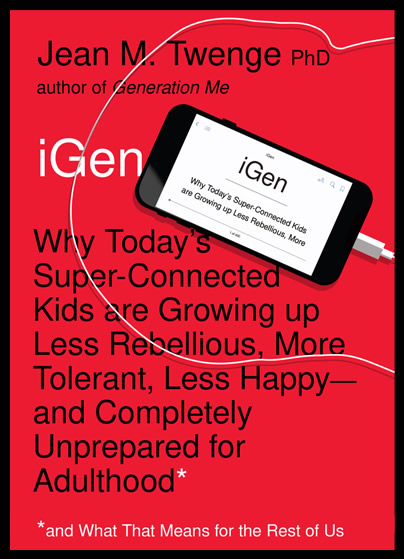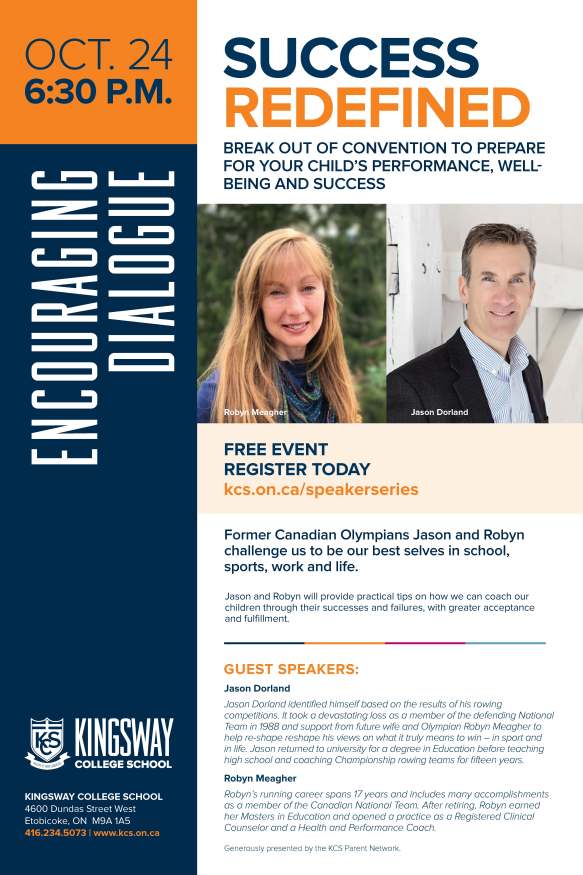If you’re reading this blog, it’s because you care about kids. You may be a parent, you may be an educator, or you may just simply be one of the many who know how much kids, and their early years, matter. Since you care about kids, there’s a book you should know about.
iGen: Why Today’s Super-Connected Kids are Growing Up Less Rebellious, More Tolerant, Less Happy – and Completely Unprepared for Adulthood was written by Dr. Jean M. Twenge, a psychology professor who specialises in personality and behaviour trends. To understand today’s kids, Twenge accessed four databases that have collectively surveyed 11 million American youth since the 1960s. Her conclusions are based on differences found between the iGen cohort and those of earlier generations (Millenials, GenX, and Boomers) in these longitudinal databases, not on surveys that focus only on one generation. Older readers will find it as interesting to learn about their own generation, as it is to see how much iGen marks a dramatic departure.
iGen’ers were born in 1995 or later, and have always lived in a world with ready access to the internet (hence the ‘i’). It’s no coincidence that some of the features of this generation align with the introduction and widespread embrace of the smartphone. Here are some of the most notable trends:
- Growing up reluctantly
On milestones that tend to mark adolescence and adulthood, iGen’ers are in less of a rush, reaching them much later, if at all:
- Comfort with leaving home
- Going out with friends
- Dating
- Drinking alcohol
- Marrying
- Having children
- Getting a job
- Taking risks
- Growing up online
This generation spends on average six hours a day of their leisure time on “new media” (texting, gaming, video chat, social media). Social media has introduced the need to “present oneself” online, which has led to the rise of selfies and the growing practice of cultivating one’s image to look perfect. Among girls, posting photos that make them appear attractive is also a distinguishing feature of this generation. The effort to gain online friends, followers, and “likes” is significant.
This generation spends less time with friends (platonic as well as boyfriends and girlfriends) in person than previous generations, but they are arguably more preoccupied with those relationships because of how they can play out online (cyberbullying, the quest for likes, the need for instant gratification/responses). Teens hanging out with their friends daily has dropped by half over the past fifteen years, with the steepest drop since 2010 (rise of the smartphone). Many explain that it’s simply more interesting to go home, game, or watch Netflix. A by-product of this is that they have less experience learning social skills, which exacerbates other problems (see #4).
- Not reading and not following news
Relative to previous generations, this cohort reads less and is less aware of what’s happening in the world. Their world, via their phones and gaming systems, is small but plenty intense to keep their interest. Despite being at their fingertips, they aren’t replacing the learning potential of books with online reading and learning. “We have the most complete and instant access to information in all of history, and we’re using it to watch funny cat videos,” notes Twenge.
- Mentally fragile
Anxiety and depression aren’t just better recognised and acknowledged these days. The symptoms of mental illness are much more widespread, to an alarming degree. Suicide rates are significantly higher among teens, and that is despite the fact that the use of antidepressants is also higher. The reduction in time spent with others, and increase in time spent online, are known to be variables that directly impact mental health. The negative effect of excessive social media on mental health is strongest for younger teens and particularly harsh for those who are already vulnerable. In addition, girls fare worse than boys. While many iGen’ers find it hard to move away from social media, many also express that they find the use of social media stressful.
Children raised by over-involved (“helicopter”) parents, another feature of this generation, experience lower psychological well-being. The preoccupation with safety and happiness made evident with this parenting style reinforces anxiety in their children.
iGen’ers also tend to get less sleep than previous generations, and much less than is healthy. This contributes to poor physical and mental health. Sleeping with their phone means their sleep is disrupted by the pings and buzzes of incoming texts. The blue light emitted by their phones also interferes with sleep.
- Pre-occupied with safety
This generation is much safer than previous generations, in large part because of their own determination to be safe. Significantly fewer drink alcohol, drive, party, get into trouble, engage in sex, and other pastimes that were more common in previous generations, and that often led to unwelcome consequences. They are less likely to be careless drivers, and less likely to drive with someone who has been drinking. Physical fights are much less common, as is sexual assault. This generation knows what is dangerous and doesn’t feel compelled to engage in it.
Their commitment to safety includes emotional safety and notable discomfort with people who say things they disagree with. This cohort finds certain topics upsetting (race relations and sexual assault were shared as two examples) and will readily launch a campaign to get professors fired and guest speakers “disinvited” should they tread into emotionally disturbing content. “Safe spaces” and “trigger warnings” (given in advance of an uncomfortable topic) are new expectations they have of universities.
iGen’ers are also relatively anxious about their financial security, making them risk-averse in their learning and pursuit of a career. Universities are expected to be places where they will be prepared for these careers, not places where they should “seek meaning” and be forced to consider ideas from multiple perspectives. They have an admirable work ethic. They know that there are no guarantees of employment and they dread the student-loan debt this questionable future includes. They are less likely to want to launch their own business because of the risk that entails. Instead, those who are keen to work want a stable job. Others, curiously, just don’t want to work and put it off as long as they can (the gaming systems are still within reach, after all).
- Reduction in religious and political affiliations
This is a cohort that is notably individualistic. They’re open-minded on most issues as long as the issues don’t affect them directly (gender rights, same-sex marriage, race relations, legalization of marijuana for example). They are less interested in being part of a group that would require them to conform to rules, beliefs, or policies. They are even less interested in conforming to their peers on fashion, stating clearly they want to be their own person (“materialistic nonconformists”). This open-mindedness doesn’t mean they have no opinions, however. In fact, this generation is notably less tolerant of those with opinions they oppose.
Twenge’s suggestions for how to help:
- Help them step away from their phones
- Delay getting a smartphone as long as possible
- Start with a flip phone or another device that isn’t connected to the internet
- Leverage online tools that restrict phone use
- Strive to keep kids from social media sites that have long feeds where they are tempted to create an online identity, and seek friends and “likes”; Snapchat is recommended because snaps only go to individuals, posts are impermanent, and there is no system of “liking” images
- Have conversations with your child about sexting, posting revealing pictures, and pornography (an alarming part of their world)
- Get kids connecting with friends in person (even if you prefer the safety of having them at home)
- Be mindful of the rise in anxiety and depression, and take steps to help your child avoid them (lower screen time, higher in-person time, exercise, proper sleep, and expert guidance as soon as needed)
- Allow, and even push, them to grow up more quickly in certain respects
- Relax curfew and rules on going out with friends
- Insist they get their driver’s license
- Consider a gap year as time for them to grow up a bit (independent travel, work…) before they go to college unprepared for the drastic change
- Reduce our preoccupation with safety
- Don’t be quick to label normal childhood conflicts “bullying”
- Avoid using safety as an excuse or explanation for practices and rules
- Model and teach children how to deal with people who express an opinion you disagree with (discuss, ignore, or develop logical arguments against it)
- Provide experiences where iGen’ers have to face (responsible) risk
- Meet them half-way at school
- Provide reading material that is more engaging, up-to-date, interactive, with shorter texts, a more conversational style, and the addition of videos, quizzes, and questionnaires
- Teach them how to judge credibility of content, evaluate sources, and recognise quality research
- Ensure that school time is relevant (they’re anxious to learn what’s needed for a job)
- Aim for depth over breadth of learning
- Intentionally coax them to ask questions and take intellectual risks
- Find ways to lessen the dramatic differences between a sheltered home life and the outside world
- Teach them how to communicate with older coworkers and clients (conversation, negotiation, email)
We can all breathe more easily knowing that many of the dangers which plagued earlier generations are responsibly avoided by iGen’ers. Twenge’s book raises new concerns, however, and we become the irresponsible generation if they’re left unconsidered. “If they can shake themselves free of the constant clutch of their phones and shrug off the heavy cloak of fear, they can still fly,” she concludes. I have the delight of raising two iGen’ers and helping to educate hundreds. Indeed, they can fly beyond our imaginations. But the data make clear that they, like all previous generations, still require help from the adults in their midst. Thanks to Twenge’s research, we can help them launch, and soar.























